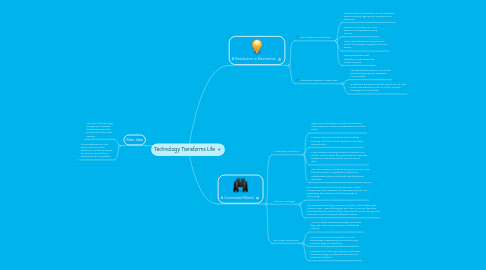
1. Main Idea
1.1. The pace of technology change has increased dramatically since the second half of the 20th century.
1.2. The development of the silicon chip and other electronic circuits has paved the way for revolutions in electronics and computers.
2. A Revolution in Electronics
2.1. The Influence of Computers
2.1.1. The earliest and most basic use of computers was computing_figuring out complex math problems.
2.1.2. Powerful computers can make billions of computations every second.
2.1.3. Many automobiles use computers to control fuel gauges, engines, and even brakes.
2.1.4. Some people fear that computers might some day control humans.
2.2. Information Spreads in New Ways
2.2.1. The Internet has become one of the most exciting ways for people to communicate.
2.2.2. In addition, people around the world can use chat rooms and electronic mail, or e-mail, to send messages to one another.
3. A Connected World
3.1. A Changing Workforce
3.1.1. Rapid communications and data transmission have helped to transform workplaces around the world.
3.1.2. Modern telecommunications allow trading, banking, and financial transactions to be done electronically.
3.1.3. Many workers are being forced to improve their skills in order to keep their jobs because high-tech industries need workers with more technical skills.
3.1.4. The technological imbalance has given rise to a new kind of economic imperislism in which the industrialized nations dominate less-developed countries.
3.2. Cultures Converge
3.2.1. The mass media-which include television, radio, movies, the music industry, and the popular press- are expanding their influence with the growth of technology.
3.2.2. The increased familiarity in Europe and the United States with African music, Asian philosophy, and Latin American literature demonstrates the power of the mass media to promote a greater awareness of and mixing of different cultures.
3.3. Old Ways Abandoned
3.3.1. As mass media spread new images and ideas, they may cause deep changes in traditional cultures.
3.3.2. Thomas Friedman worries that so much technology is weakening the old and more personal ways of interacting.
3.3.3. Somtimes the challange posed by new ideas and technology can stimulate the desire to preserve traditions.
